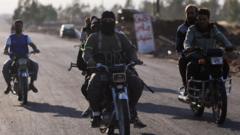With both Iran and the U.S. seeking to frame their narratives as victories, the prospect of a ceasefire hangs in the balance.
**Navigating the Intricacies of the Iran-Israel Dispute: A Potential Shift Towards Ceasefire**

**Navigating the Intricacies of the Iran-Israel Dispute: A Potential Shift Towards Ceasefire**
A nuanced analysis emerges as Iran and the U.S. engage in a delicate dance following recent military confrontations.
In the wake of escalating tensions between Iran, Israel, and the United States, the situation has transformed into a complex conflict with implications extending far beyond military might. Following a series of recent attacks on Iranian military sites, Iran's Supreme National Security Council convened an emergency meeting. The agenda: strategizing a measured response to the American bombings of key nuclear facilities while preserving its regional standing.
Iran's leadership recognized the need for retaliation, yet there was a conscious effort to avoid spiraling into an all-out war. Led by Ayatollah Ali Khamenei, officials deliberated on a strike that would send a message without inviting further aggression. Ultimately, the Revolutionary Guards selected the Al Udeid Air Base in Qatar as the target, deeming it a viable option. The reasoning hinged on its significance in the U.S. military infrastructure while managing the potential fallout in a nation that fosters closer ties with Iran.
By opting for this action, Iranian forces communicated discontent toward the U.S. without provoking extensive military engagement. Interestingly, the measure allowed Iran to tailor its narrative around resilience and strength, portraying the strike as a notable response while potentially paving the way for diplomatic discussions.
As grappling nations attempt to emerge from this fraught encounter, the overarching possibility of a ceasefire rises. It paints a picture of a complex web of diplomatic engagement amid military operations, where both parties aim to claim triumph while averting further conflict. Thus, the reported lack of casualties among American forces provides a glimmer of hope, enabling a pause that could signal the onset of more profound negotiations aimed at establishing peace in the region.
Iran's leadership recognized the need for retaliation, yet there was a conscious effort to avoid spiraling into an all-out war. Led by Ayatollah Ali Khamenei, officials deliberated on a strike that would send a message without inviting further aggression. Ultimately, the Revolutionary Guards selected the Al Udeid Air Base in Qatar as the target, deeming it a viable option. The reasoning hinged on its significance in the U.S. military infrastructure while managing the potential fallout in a nation that fosters closer ties with Iran.
By opting for this action, Iranian forces communicated discontent toward the U.S. without provoking extensive military engagement. Interestingly, the measure allowed Iran to tailor its narrative around resilience and strength, portraying the strike as a notable response while potentially paving the way for diplomatic discussions.
As grappling nations attempt to emerge from this fraught encounter, the overarching possibility of a ceasefire rises. It paints a picture of a complex web of diplomatic engagement amid military operations, where both parties aim to claim triumph while averting further conflict. Thus, the reported lack of casualties among American forces provides a glimmer of hope, enabling a pause that could signal the onset of more profound negotiations aimed at establishing peace in the region.





















